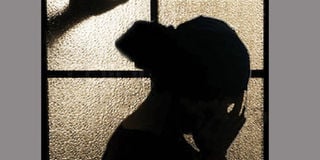Kilifi records highest incidence of rape in Kenya, says report

According to the National Crime Research Centre, verbal abuse ranged from a low of 4.2 per cent in Kilifi to a high of 95.6 per cent in Mombasa. PHOTO | FILE | NATION MEDIA GROUP
What you need to know:
- According to the Kenya Demographic and Health Survey 2014, 47 per cent of women aged between 15 and 49 had experienced either physical or sexual violence.
- Mombasa recorded the highest incidence of verbal abuse, followed by Busia (67.3 per cent), Machakos (66.7 per cent), Meru (66.3 per cent) and Kisii (57.1 per cent).
Kilifi County has the highest rape prevalence in the country, according to a report released by the National Crime Research Centre.
The report on gender-based violence (GBV) in Kenya, released by the centre in 2014, put the prevalence of rape in Kilifi at 97.9 per cent. Samburu, on the other hand, recorded the lowest, with 7.9 per cent.
Behind Kilifi were Kisii (85.7 per cent), Machakos (71.4 per cent), Mombasa (66.7 per cent) and Nairobi (64.9 per cent).
The report also showed that Mombasa had the highest rate of defilement (60 per cent), followed by Machakos (58.3 per cent), Kisii (57.1 per cent), Nairobi (24.5 per cent) and Nyeri (17.5 per cent).
With regard to non-sexual assault, the top five counties were Samburu (42.9 per cent), Kisii (42.9 per cent), Mombasa (22.2 per cent), Nairobi (21.3 per cent) and Nakuru (20 per cent).
Hitting, battering and beating were the most prevalent forms of GBV and were reported in all counties. This form of violence ranged from a low of 38.5 per cent in Nakuru to a high of 97.8 per cent in Mombasa.
VERBAL ABUSE
The top five counties as regards hitting, battering and beating were found to be Mombasa (97.8 per cent), Machakos (95.2 per cent), Samburu (95.2 per cent), Kisii (92.9 per cent), Meru (88 per cent) and Busia (82.7 per cent).
Domestic conflict ranged from a low of 12.5 per cent in Kilifi to a high of 90.5 per cent in Machakos.
It was most prevalent in Machakos (90.5 per cent), Migori (86.6 per cent), Meru (66.3 per cent), Kisii (64.3 per cent) and Busia (61.5 per cent).
Verbal abuse ranged from a low of 4.2 per cent in Kilifi to a high of 95.6 per cent in Mombasa.
Mombasa recorded the highest incidence of verbal abuse, followed by Busia (67.3 per cent), Machakos (66.7 per cent), Meru (66.3 per cent) and Kisii (57.1 per cent).
“Generally, the above findings are an indication that most counties experience different types of GBV in varying proportions. Focus needs to be on addressing all forms of GBV in all counties, but with emphasis on counties (such as Kilifi, Kisii, Machakos, Meru, Mombasa and Nairobi) which featured prominently, especially in the serious forms of GBV,” said the report.
According to the Kenya Demographic and Health Survey 2014, 47 per cent of women aged between 15 and 49 had experienced either physical or sexual violence.
SEXUAL VIOLENCE
The survey also indicated that 33 per cent had experienced physical violence, with three per cent having experienced sexual violence alone, and 12 per cent both physical and sexual violence.
The percentage of women who had experienced physical or sexual violence increased steadily with age, from 35 per cent among those aged 15-19, to 54 per cent among those aged 40-49.
The incidence of sexual violence against women was lowest (at six per cent or less) among Muslims, in northeastern Kenya and never married women.
The percentages of women who had ever experienced sexual violence or a year before the survey was lower among those with a secondary (11 per cent) or higher education (5 per cent), and wealthy women (11 per cent) than in women in categories other than these.
The report also cited the perpetrators of sexual violence, with spouses/partners being found among ever-married women and men at 55 and 37 per cent and former spouses at 28 per cent and 25 per cent respectively.





